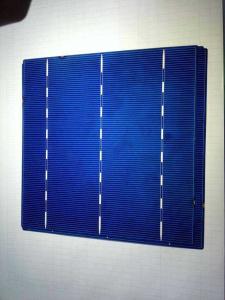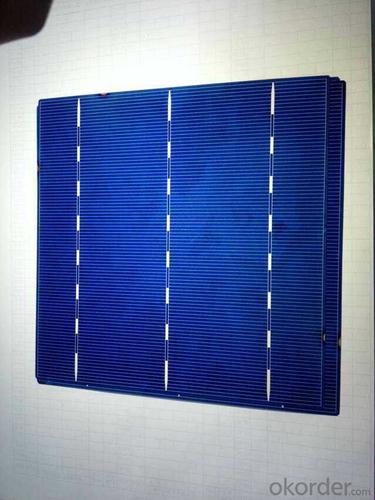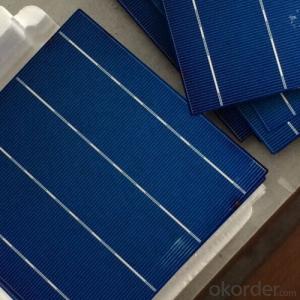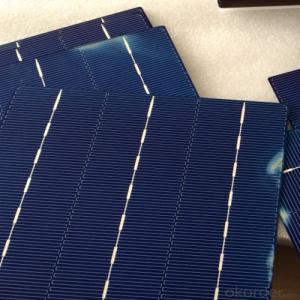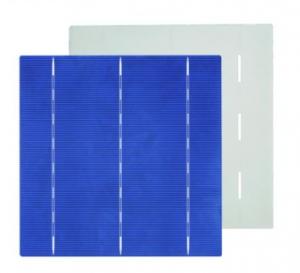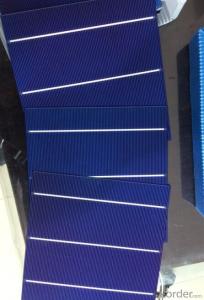Cheap Solar Cells China - Poly 3 Busbar Solar Cells Four Busbar B Grade Lower Price
- Loading Port:
- Shanghai
- Payment Terms:
- TT or LC
- Min Order Qty:
- 30000 pc
- Supply Capability:
- 3000000 pc/month
OKorder Service Pledge
OKorder Financial Service
You Might Also Like
Product description
Poly Solar Cells 156*156mm B Grade Low Price
A solar cell, or photovoltaic cell, is an electrical device that converts the energy of light directly into electricity by the photovoltaic effect, which is a physical and chemical phenomenon.[1] It is a form of photoelectric cell, defined as a device whose electrical characteristics, such as current, voltage, or resistance, vary when exposed to light. Solar cells are the building blocks of photovoltaic modules, otherwise known as solar panels.
Solar cells are described as being photovoltaic irrespective of whether the source is sunlight or an artificial light. They are used as a photodetector (for example infrared detectors), detecting light or other electromagnetic radiation near the visible range, or measuring light intensity.
In contrast, a solar thermal collector supplies heat by absorbing sunlight, for the purpose of either direct heating or indirect electrical power generation from heat. A "photoelectrolytic cell" (photoelectrochemical cell), on the other hand, refers either to a type of photovoltaic cell (like that developed by Edmond Becquerel and modern dye-sensitized solar cells), or to a device that splits water directly into hydrogen and oxygen using only solar illumination.
Advantage Of Poly Solar Cell 156mm
1: High quality cell, Level A cell (14%—17.5%)
2.Dimensione:156*156mm Diagonal:200mm
3: Qualified certification: TUV,CE certification.
4: Warranty: five years for whole unit
Usage/Application Of Poly Solar Cell 156mm
1.The absorption of light, generating either electron-hole pairs or excitons.
2.The separation of charge carriers of opposite types.
3.The separate extraction of those carriers to an external circuit.
Product Images
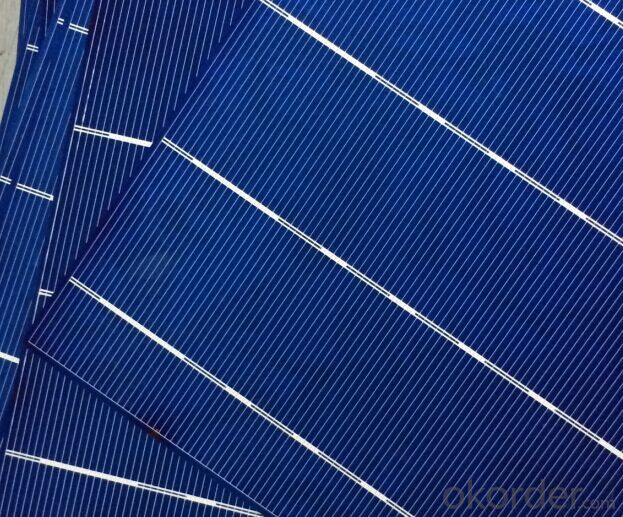

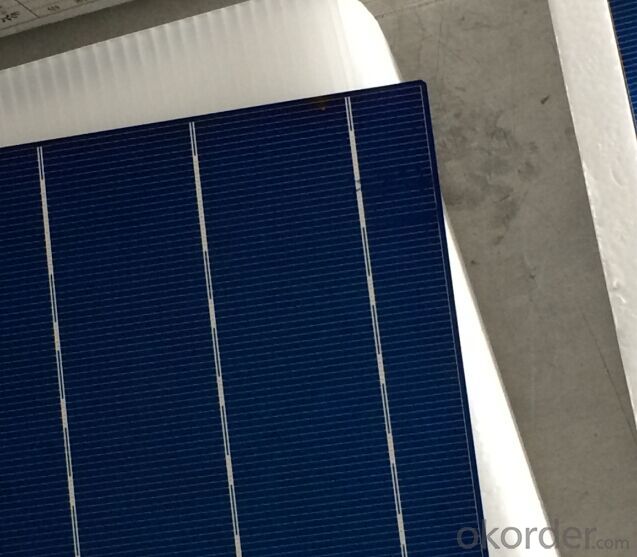
Mechanical data and design
Format | 156 mm × 156 mm ± 0.5 mm |
Thickness | 210 μm ± 40 μm |
Front(-) | 1.5mm bus bars (silver),blue anti-reflection coating (silicon nitride) |
Back (+) | 2.5 mm wide soldering pads (silver) back surface field (aluminium) |
Temperature Coefficient of Cells
Voc. Temp . coef.%/K | -0.351%/K |
Isc . Temp . coef.%/K | +0.035%/K |
Pm. Temp. coef.%/K | -0.47%/K |
Electrical Characteristic
Efficiency (%) | Pmpp (W) | Umpp (V) | Impp (A) | Uoc (V) | Isc (A) | FF (%) |
17.25 | 4.197 | 0.524 | 7.992 | 0.62 | 8.458 | 80.03% |
17 | 4.137 | 0.524 | 7.876 | 0.619 | 8.353 | 80.01% |
16.75 | 4.076 | 0.522 | 7.81 | 0.617 | 8.286 | 79.73% |
16.5 | 4.015 | 0.518 | 7.746 | 0.613 | 8.215 | 79.73 |
16.25 | 3.955 | 0.515 | 7.683 | 0.61 | 8.144 | 79.61% |
16 | 3.894 | 0.512 | 7.613 | 0.608 | 8.075 | 79.31% |
15.75 | 3.833 | 0.51 | 7.534 | 0.605 | 8.058 | 78.62% |
15.5 | 3.772 | 0.508 | 7.453 | 0.604 | 8.02 | 77.87% |
15.25 | 3.771 | 0.505 | 7.35 | 0.604 | 9.997 | 76.83% |
15 | 3.65 | 0.503 | 7.271 | 0.604 | 7.989 | 75.64% |
14.5 | 3.529 | 0.499 | 7.067 | 0.604 | 7.988 | 73.14% |
14 | 3.407 | 0.499 | 6.833 | 0.604 | 7.833 | 72.01% |
Intensity Dependence
Intensity [W/m2] | Isc× [mA] | Voc× [mV] |
1000 | 1.00 | 1.000 |
900 | 0.90 | 0.989 |
500 | 0.50 | 0.963 |
300 | 0.30 | 0.939 |
200 | 0.20 | 0.920 |
FAQ
Q:What price for each watt?
A:It depends on the quantity, delivery date and payment terms
Q:What is your warranty system?
A:Our Solar cells performance guarantees for 25 years
Q:How do you pack your products?
Brief introduction of 3 busbar solar cell
Solar cells, also known as "Solar chip" or "photovoltaic cell”, is a direct use of solar photovoltaic power generation semiconductor slice. As long as it is light that can be instantaneous output voltage and in the case of the circuit generates a current situation.
3 Busbar solar cell convert light into electrical energy through the photoelectric effect or photochemical effect directly. In the photoelectric effect of thin-film solar cells work for the mainstream, and to the implementation of the work photochemical effects of solar cells is still in its infancy.
Working principle of 3 busbar solar cell
Sun lights in the semiconductor p-n junction, forming a new hole - electron pairs in the p-n junction built-in electric field, the photo-generated holes flow to the p region, the photo-generated electrons flow into the n region, after turning circuit current. This is how the photovoltaic solar cell works.
There are two ways 3 busbar solar power working in, one is light - heat - electricity conversion mode, the other is light - electric direct conversion method.
Briefly, solar photovoltaic power generation principle is the use of solar cells to absorb 0.4μm ~ 1.1μm wavelength (for silicon) sunlight, light energy being converted into electric energy directly.
Since electricity generated by 3 busbar solar cells is DC, so if you provide electricity to all kinds of electrical appliances used in home or industrial need to install DC / AC converter, to change it into alternating current.
Most of the rechargeable solar cells apply in consumer products have charging problem. In the past general object takes charge NiMH or nickel cadmium batteries, nickel-metal hydride batteries but cannot withstand high temperatures and nickel-cadmium batteries have environmental pollution.
Super capacitor rapid development, large capacity, anti narrow area, coupled with low prices, it is part of the solar products began to shift to the super capacitor charging objects, thereby improving many of the problems of solar charging:
Charge faster,
The long life of more than 5 times,
Charging a wide temperature range,
Reduce the amount of solar cells (which can be low voltage charging).
- Q: How do solar cells perform in regions with frequent thunderstorms?
- Solar cells are not directly affected by thunderstorms themselves. However, frequent thunderstorms in a region can lead to reduced sunlight exposure, which may affect the overall performance of solar cells.
- Q: What is the impact of wind on solar cell efficiency?
- The impact of wind on solar cell efficiency is generally minimal. While strong winds can cause slight vibrations in solar panels, it does not significantly affect the overall efficiency of the cells. In fact, a gentle breeze can even help to keep the panels cool, preventing overheating and potentially improving their performance. However, extreme winds or storms can pose a risk of physical damage to the panels, which could impact their efficiency if not properly addressed.
- Q: How about the solar cell 156mm Mono-Crystalline?
- If you are getting this kind of solar cells-Mono Solar Cell measure by 156mm, the light intensity is 1000W/㎡, 25 ℃, AM1.5
- Q: Can solar cells be used in space stations?
- Yes, solar cells can be used in space stations. In fact, they are extensively used to generate electricity in space stations such as the International Space Station (ISS). Solar cells capture sunlight and convert it into electricity, providing a reliable and sustainable source of power for various systems and experiments onboard the space station.
- Q: Can solar cells be used in educational institutions?
- Yes, solar cells can be used in educational institutions. They can be used to generate clean and renewable energy, which can help reduce the institution's carbon footprint and energy costs. Additionally, solar cells can serve as an educational tool, allowing students to learn about sustainable energy sources and the importance of environmental conservation.
- Q: Does solar cell cost less than the other power generation technology?
- Since it saves a lot of energy, and make less damage to the environment, it is considered less cost as a way to generate the power.
- Q: Is the Photovoltaic cell panel good to save the energy?
- The Photovoltaic cell panel is actually very much developed for saving the energy. After several years of research and development, the third generation solar cells (including various semiconducting properties at the molecular level of the material) has already being used.
- Q: Can solar cells be used in electric grid stabilization?
- Yes, solar cells can be used in electric grid stabilization. Solar power can contribute to stabilizing the electric grid by providing a consistent and reliable source of renewable energy. The excess energy generated during peak sunlight hours can be stored in batteries or fed back into the grid, helping to balance the supply and demand. Additionally, solar power can reduce the reliance on traditional power plants, thereby reducing the risk of grid instability caused by disruptions in fossil fuel supply or sudden variations in demand.
- Q: How is the efficiency of a solar cell calculated?
- The efficiency of a solar cell is calculated by dividing the maximum power output of the solar cell by the total amount of solar energy it receives.
- Q: Can solar cells be used to power homes?
- Yes, solar cells can be used to power homes. Solar panels, made up of multiple solar cells, convert sunlight into electricity that can be used to power household appliances and lighting. This renewable energy source can provide a sustainable and cost-effective solution for residential power needs.
Send your message to us
Cheap Solar Cells China - Poly 3 Busbar Solar Cells Four Busbar B Grade Lower Price
- Loading Port:
- Shanghai
- Payment Terms:
- TT or LC
- Min Order Qty:
- 30000 pc
- Supply Capability:
- 3000000 pc/month
OKorder Service Pledge
OKorder Financial Service
Similar products
Hot products
Hot Searches
Related keywords
